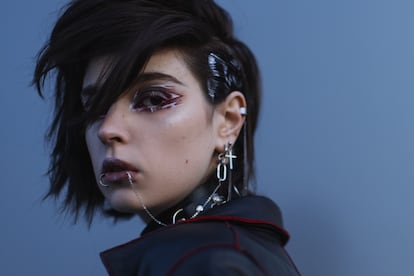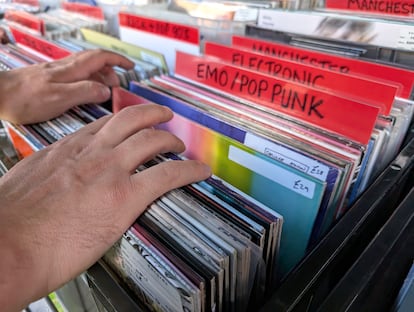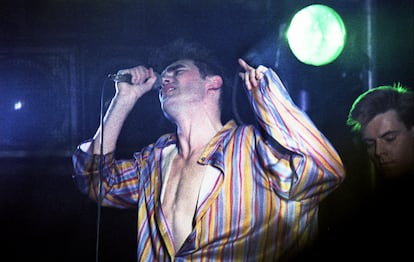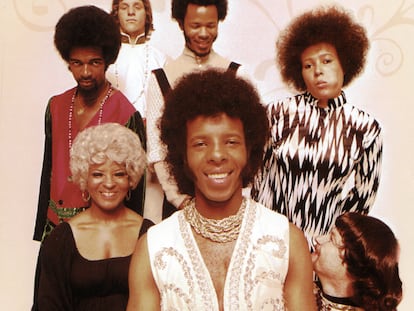How emos survived their sadness: The ashes of an extinct urban tribe on the verge of resurrection
Bangs, heavy eyeliner, black skinny jeans, and melancholy — these were the trademarks of the emo subculture, which experienced a massive boom among teenagers in the 2000s. Now, it seems to have disappeared. But could it make a comeback with Generation Alpha?


On September 11, 2001, a 20-year-old on his way to work witnessed firsthand the brutal attack that brought down the Twin Towers in New York City — an act of terrorism that left an indelible mark on the American psyche and exposed the vulnerabilities of a nation long seen as invincible. That young man was Gerard Way. Nearly two decades later, he would reveal in an interview that 9/11 was the catalyst that drove him to call a friend and write the first song that would appear on the debut album of My Chemical Romance.
Blending elements of emo, pop-punk, and rock, the band introduced a narrative and aesthetic style infused with theatricality and emotional intensity. While My Chemical Romance didn’t invent emo — a genre that originated in the 1980s as a subgenre of hardcore punk — they embraced its core ethos: the expression of longing for a better past, and the affirmation of vulnerability, loneliness, and sadness as ways of engaging with the world.
This cocktail of emotions, delivered through music and a rebellious aesthetic that pushed the styles of earlier bands like Nirvana and Green Day to new extremes, resonated deeply — especially with teenagers. They saw themselves reflected in the band’s narrative and performance. Bold eyeliner, long bangs, facial piercings and punk-inspired studs, skinny jeans borrowed from rock, and the unkempt look of grunge became markers of a mass fashion movement. Thanks to support from MTV, which began championing bands from this emerging scene, emo grew into a teenage phenomenon that spawned an aesthetically distinct urban tribe.
According to Carles Feixa, professor of social anthropology at Pompeu Fabra University in Barcelona, emo is closely tied to the emotional turbulence of adolescence and early adulthood. “Just as other urban tribes are linked to broader social, economic, or political crises, emo explores the individual emotional crisis,” he says.
Emo bands of the 2000s wrote lyrics steeped in melancholy and alienation — feelings that strongly resonated with teenagers navigating their own formative struggles. For those who felt like outsiders in traditional social circles, the emo scene offered a safe haven: a space where emotional expression, through music, fashion, and attitude, could be embraced without fear of judgment. Platforms like MySpace, Tumblr, and Reddit played a crucial role in amplifying this countercultural movement, whose driving force was the expression of melancholy.

In the early 2000s, emo wasn’t the only urban tribe taking shape. Alongside the rise of the internet, other youth subcultures tied to different musical genres began gaining popularity, coexisting with groups that had already emerged in the 1980s and 1990s. This period gave rise to a curious mosaic of identities. Amid them all, emo occupied the niche of the misunderstood outsider — the one who didn’t quite belong anywhere else.
In this regard, cultural anthropologist Iñaki Domínguez points out that “emo was part of the wave of the new romantics, following in the footsteps of grunge, goth, or dark subcultures.”
To sketch the archetype of the emo teenager, Domínguez describes them as “the classic figure of the misunderstood kid, a type that also existed in the 1980s and ’90s.” For Domínguez, a quintessential example of this persona can be found in The Smiths of the 1980s. Though not musically aligned with emo, frontman Morrissey embodied that archetype of the tormented, romantically sensitive youth, who was sexually ambiguous and had an interest in punk.

The death of urban tribes
The emo craze began to lose steam around 2010 for several reasons: first, the bands that had represented the genre shifted toward a more commercial sound, and the pursuit of the underground started to spark friction between different emo subgroups. That loss of direction led some of those bands to break up. On the other hand, the rise of social networks like Instagram homogenized the dominant aesthetic, and the stark differences between existing urban tribes began to blur. In fact, experts argue that urban tribes largely disappeared after 2015.
Roger Martínez Sanmartí, a sociology professor at the Open University of Catalonia, believes one reason is that teenagers today generally go out much less than they used to, and there’s less street life. “The face-to-face rituals tied to music and dressing a certain way to stand out from the crowd have lost their strength. Instagram or TikTok spread labels that help many people position themselves in relation to something, but they quickly become obsolete because everything moves so fast,” he says.
Regarding this loss of group identity among teenagers, sociologist Domínguez adds another reason: “On the internet, it seems like there’s endless diversity, but in the end, the truly powerful platforms are very few, and what they foster is total uniformity. All the kids want the same sneakers, they more or less listen to the same music, and they follow the same trends.”
He concludes: “We can’t sell the idea that urban tribes were ultra-radical because they were also a kind of herd behavior, in the sense of adopting a preset aesthetic — but they did contribute to a kind of diversity that doesn’t exist today.”

What happened to the emos?
The teens who were emo in the 2000s grew up and became adults. It makes no sense that a youth subculture built around the crisis of adolescence to carry on much past 18. And yet, the feeling of belonging that emo once offered still lives on more strongly than with many other subcultures.
“I don’t declare myself an emo today the same way I did when I was 14, but it’s a movement I find hard to separate from who I am now, because it helped me shape my personality,” says Marc Iznardo, a 27-year-old emo.
On the other hand, YouTuber and expert in internet culture and urban tribes Esty Quesada says she was, is, and always will be emo: “Being emo now that I’m 30 is a little pathetic, but for me, it has been everything. I found it when I was 12 or 13 and what I saw there was an option for darkness, an approach to certain feelings that I had inside and that, growing up in a small town, I saw didn’t fit in with others.”
Thanks to that dark aesthetic and bands like A Vain Attempt, Esty says she found companionship, understanding, and support. She believes emo is far from dead: “Emo exists, but you have to seek it out. Right now, I think we’re experiencing a revival.”
For her, emo has always carried a kind of intellectual elitism, where the most emo thing was to deny being emo at all. “We’re living in more superficial times now, and since no one cares about you, you don’t have to say you’re depressed to justify your bangs,” she says.
What’s clear is that the highly defined emo aesthetic has evolved a lot over the past 15 years. “The mall emo phase eventually started blending with the scene,” Quesada explains — referring to a musical and visual offshoot that brought back post-hardcore while injecting color into the emo palette, merging the dark with the flashy.
“Nowadays, thanks to TikTok, figures like 6arelyhuman and Britney Manson are bringing that scene back. I see a lot of videos of 15-year-olds in the United States going out with their friends and all dressed in emo, just like in 2008,” he adds.
Sign up for our weekly newsletter to get more English-language news coverage from EL PAÍS USA Edition
Tu suscripción se está usando en otro dispositivo
¿Quieres añadir otro usuario a tu suscripción?
Si continúas leyendo en este dispositivo, no se podrá leer en el otro.
FlechaTu suscripción se está usando en otro dispositivo y solo puedes acceder a EL PAÍS desde un dispositivo a la vez.
Si quieres compartir tu cuenta, cambia tu suscripción a la modalidad Premium, así podrás añadir otro usuario. Cada uno accederá con su propia cuenta de email, lo que os permitirá personalizar vuestra experiencia en EL PAÍS.
¿Tienes una suscripción de empresa? Accede aquí para contratar más cuentas.
En el caso de no saber quién está usando tu cuenta, te recomendamos cambiar tu contraseña aquí.
Si decides continuar compartiendo tu cuenta, este mensaje se mostrará en tu dispositivo y en el de la otra persona que está usando tu cuenta de forma indefinida, afectando a tu experiencia de lectura. Puedes consultar aquí los términos y condiciones de la suscripción digital.
More information
Archived In
Últimas noticias
Chris Martin, Taylor Swift, Elijah Wood and other famous wedding ‘crashers’
‘How does it feel to be a failure?’: Elizabeth Berkley’s journey from ‘Showgirls’ ridicule to vindication
The story of the Málaga virus: The code that haunted Google’s cybersecurity center director for 30 years
The impact of Ecuador’s mega-prison: A polluted river, cleared forests and military checkpoints
Most viewed
- The low-cost creative revolution: How technology is making art accessible to everyone
- Christian Louboutin: ‘Young people don’t want to be like their parents. And if their parents wear sneakers, they’re going to look for something else’
- All the effects of gentrification in one corner of Mexico’s Colonia Roma
- Liset Menéndez de la Prida, neuroscientist: ‘It’s not normal to constantly seek pleasure; it’s important to be bored, to be calm’
- December Social Security and SSI payments: Dates, double checks and the 2026 COLA increase










































